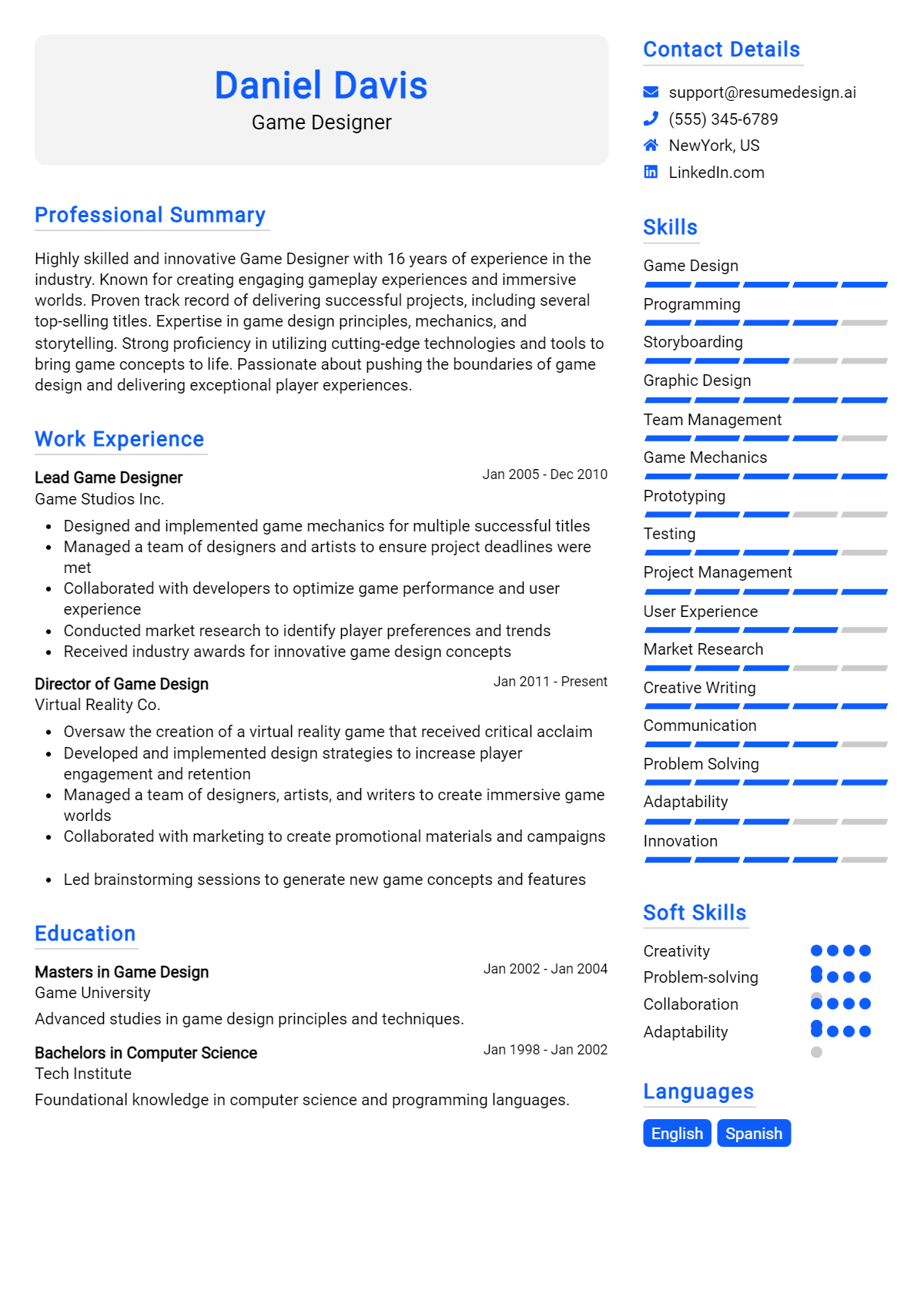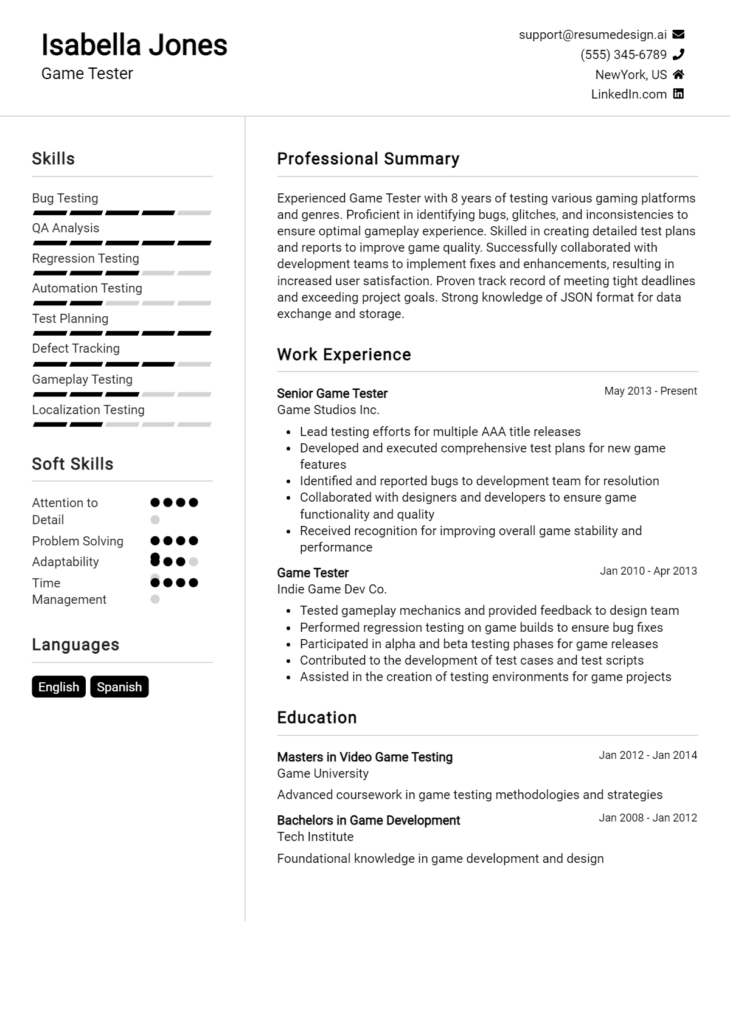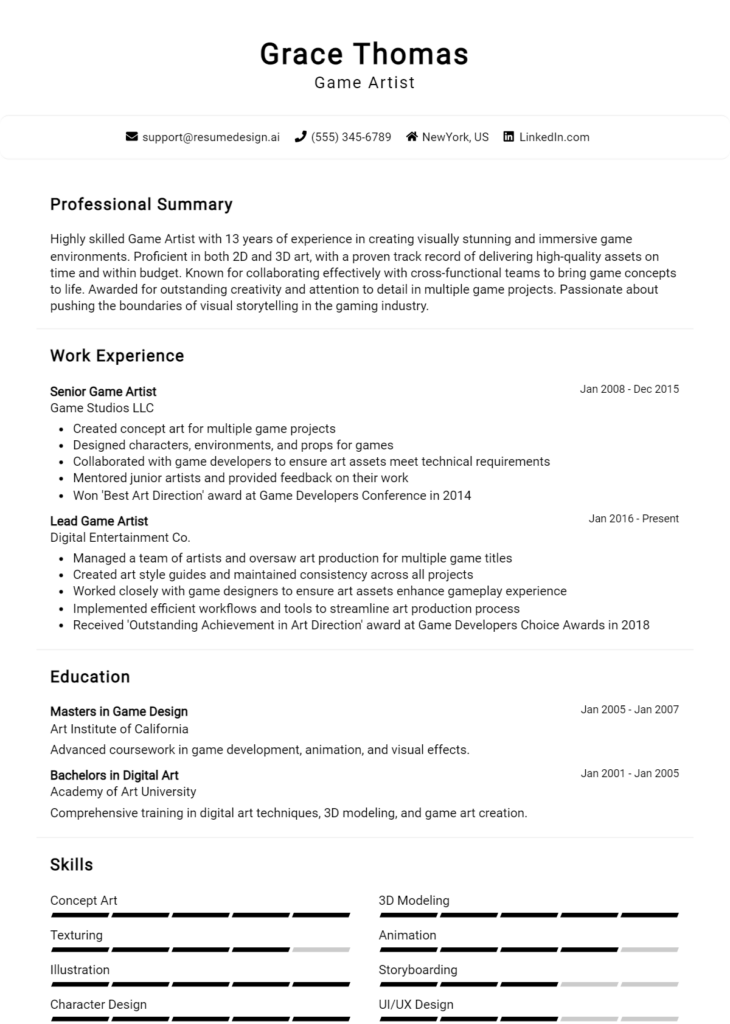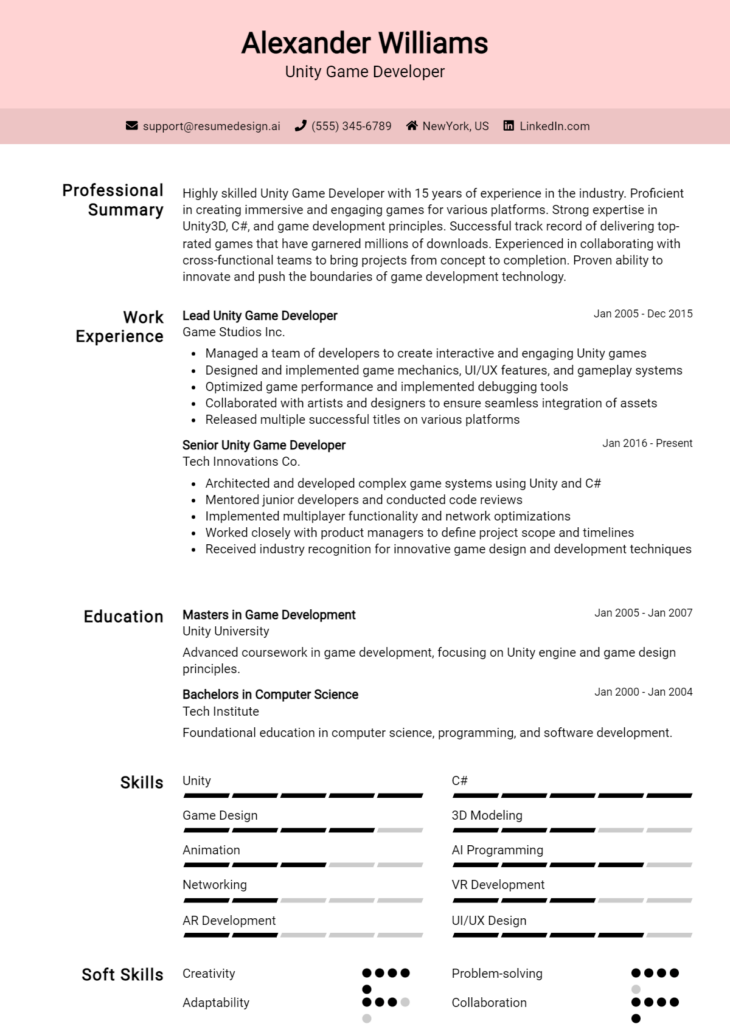Game Designer Core Responsibilities
A Game Designer plays a pivotal role in creating engaging gameplay experiences by collaborating with artists, programmers, and writers. The key responsibilities include conceptualizing game mechanics, designing levels, and balancing gameplay. Essential skills include technical proficiency in game development tools, strong operational strategies, and adept problem-solving abilities. These competencies are vital for achieving the organization’s objectives, enhancing player satisfaction, and driving game success. A well-structured resume can effectively showcase these qualifications, making a candidate stand out.
Common Responsibilities Listed on Game Designer Resume
- Developing and refining game concepts and mechanics.
- Creating detailed design documents and specifications.
- Collaborating with artists and programmers to implement game features.
- Designing engaging levels and environments.
- Conducting playtesting and gathering player feedback.
- Balancing game difficulty and player progression.
- Ensuring alignment with the overall game vision and goals.
- Staying updated with industry trends and technologies.
- Participating in brainstorming sessions and team meetings.
- Debugging and troubleshooting gameplay issues.
- Creating and maintaining project timelines and documentation.
High-Level Resume Tips for Game Designer Professionals
In the competitive world of game design, a well-crafted resume is not just a document; it's your first chance to make a lasting impression on potential employers. As a game designer, your resume should not only showcase your technical skills but also reflect your creativity and achievements within the industry. It serves as a marketing tool that helps you stand out from the crowd, demonstrating your passion for game design and your ability to contribute to innovative projects. This guide will provide practical and actionable resume tips specifically tailored for Game Designer professionals, ensuring you present your best self to potential employers.
Top Resume Tips for Game Designer Professionals
- Tailor your resume to match the job description by incorporating relevant keywords and phrases.
- Highlight your most relevant experience at the top, focusing on roles that directly relate to game design.
- Quantify your achievements with specific metrics, such as the number of projects completed or user engagement statistics.
- Showcase your proficiency in industry-standard software and tools, like Unity, Unreal Engine, or Adobe Creative Suite.
- Include a portfolio link to your best work, demonstrating your design process and end results.
- Emphasize collaboration skills by mentioning teamwork experiences and cross-functional projects.
- Detail your understanding of game mechanics, storytelling, and user experience design principles.
- List any relevant certifications or courses that enhance your qualifications in game design.
- Utilize a clean, visually appealing format that reflects your creative flair while remaining professional.
Implementing these tips can significantly increase your chances of landing a job in the Game Designer field. By crafting a resume that effectively showcases your skills, experience, and creative accomplishments, you position yourself as a strong candidate who is ready to contribute to exciting projects in the gaming industry. Remember, your resume is your personal marketing tool—make it count!
Why Resume Headlines & Titles are Important for Game Designer
In the competitive field of game design, a well-crafted resume headline or title can serve as a powerful tool to capture the attention of hiring managers. A strong headline encapsulates a candidate's key qualifications and expertise in a succinct phrase, providing an immediate impression of their suitability for the role. By effectively summarizing their skills and experience, a compelling resume title not only stands out but also sets the tone for the rest of the application. It should be concise, relevant, and directly aligned with the job being pursued, ensuring that it resonates with the specific requirements of the game design position.
Best Practices for Crafting Resume Headlines for Game Designer
- Keep it concise: Aim for a headline that is brief yet descriptive, ideally no more than 10 words.
- Be role-specific: Tailor the headline to reflect the specific game design position you are applying for.
- Highlight key skills: Incorporate essential skills or experiences that align with the job description.
- Use action-oriented language: Employ strong verbs to convey your proactive approach and accomplishments.
- Avoid jargon: Use clear and accessible language that can be easily understood by hiring managers.
- Showcase unique strengths: Emphasize what sets you apart from other candidates, such as specific technologies or methodologies.
- Consider your audience: Tailor your headline to appeal to the specific company or game genre you are targeting.
- Revise for impact: Regularly update your headline to ensure it reflects your most recent accomplishments and skills.
Example Resume Headlines for Game Designer
Strong Resume Headlines
Innovative Game Designer Specializing in Immersive User Experiences
Award-Winning Game Designer with 5+ Years in Mobile Gaming
Creative Game Developer Skilled in Unity and Gameplay Mechanics
Lead Game Designer with Proven Track Record in Multiplayer Games
Weak Resume Headlines
Game Designer
Experienced in Game Development
Seeking Game Design Position
The strong headlines are effective because they clearly communicate the candidate’s unique qualifications and areas of expertise, immediately drawing attention to their relevant skills and accomplishments. In contrast, the weak headlines fail to impress as they lack specificity and do not convey any distinct value, making them easily forgettable in a sea of applications. A compelling headline is essential for setting a candidate apart and making a lasting first impression.
Writing an Exceptional Game Designer Resume Summary
A well-crafted resume summary is vital for a Game Designer as it serves as the first impression a hiring manager has of a candidate. A strong summary succinctly captures the essence of the applicant’s skills, experiences, and accomplishments relevant to game design, making it easier for employers to quickly assess qualifications. By providing a concise and impactful overview tailored specifically to the job in question, candidates can effectively highlight their unique contributions and stand out in a competitive job market.
Best Practices for Writing a Game Designer Resume Summary
- Quantify Achievements: Use numbers to showcase your impact, such as the number of projects completed or revenue generated from a game.
- Focus on Key Skills: Highlight specific skills relevant to game design, such as proficiency in game engines, programming languages, or art design.
- Tailor to the Job Description: Customize your summary to align with the specific requirements and responsibilities outlined in the job posting.
- Showcase Industry Experience: Mention years of experience and any notable companies or projects you’ve worked with.
- Highlight Awards and Recognition: Include any accolades or recognitions that demonstrate your talent and dedication in the field.
- Keep it Concise: Aim for 3-5 sentences that effectively summarize your qualifications without unnecessary fluff.
- Use Strong Action Verbs: Start sentences with action verbs to convey your accomplishments and responsibilities dynamically.
Example Game Designer Resume Summaries
Strong Resume Summaries
Creative Game Designer with over 7 years of experience in developing engaging mobile and console games. Spearheaded a team that launched a top-10 ranked mobile game, achieving over 1 million downloads within the first month, increasing company revenue by 25%.
Detail-oriented Game Designer with expertise in Unity and C#. Developed 5 successful indie games, three of which received industry awards, contributing to a 150% increase in player engagement across all platforms.
Innovative Game Designer proficient in level design and user experience. Successfully led the redesign of a flagship game, resulting in a 40% increase in player retention and a significant boost in in-game purchases.
Weak Resume Summaries
Game Designer with some experience in the industry. I have worked on various projects and am passionate about creating games.
Dedicated individual looking for a Game Designer position. I have knowledge of game design principles and enjoy working on creative projects.
The examples provided illustrate the difference between strong and weak resume summaries. Strong summaries are specific, highlight quantifiable achievements, and demonstrate relevant skills that align with the job role. In contrast, weak summaries are vague and lack concrete details or measurable outcomes, making them less compelling to hiring managers. By focusing on clarity and impact, candidates can significantly enhance their chances of making a positive impression.
Work Experience Section for Game Designer Resume
The work experience section of a Game Designer resume is critical for demonstrating a candidate's practical knowledge and expertise in the gaming industry. It serves as a platform for showcasing not only technical skills and proficiency with various design software but also the ability to manage teams and deliver high-quality products on time. By quantifying achievements—such as increased player engagement or successful project launches—and aligning experiences with industry standards, candidates can effectively illustrate their value to potential employers, making a compelling case for their candidacy.
Best Practices for Game Designer Work Experience
- Highlight relevant technical skills such as proficiency in game engines (e.g., Unity, Unreal Engine).
- Quantify results wherever possible, using metrics to illustrate the impact of your work.
- Emphasize collaboration by detailing teamwork and cross-functional project experiences.
- Showcase leadership roles in projects, demonstrating your ability to manage teams or mentor others.
- Align your experiences with industry standards and best practices to show relevance.
- Use action verbs to describe your contributions and achievements effectively.
- Include a diverse range of projects to show versatility in game design styles and genres.
- Tailor your work experiences to the specific job description to make a stronger connection.
Example Work Experiences for Game Designer
Strong Experiences
- Led a team of 5 designers to develop a mobile game that achieved over 1 million downloads within the first month, increasing user engagement by 30%.
- Designed and implemented game mechanics for a AAA title, resulting in a 25% increase in player retention rates through enhanced gameplay dynamics.
- Collaborated with artists and programmers to produce an award-winning indie game, securing a nomination for Best Indie Game at the XYZ Awards.
- Managed the entire lifecycle of a virtual reality project, from concept to launch, delivering the product 2 weeks ahead of schedule while staying under budget by 15%.
Weak Experiences
- Worked on various game projects.
- Assisted in designing levels for a game.
- Participated in team meetings to discuss game ideas.
- Helped to improve game graphics.
The examples provided illustrate the difference between strong and weak experiences in a Game Designer resume. Strong experiences are specific, quantifiable, and demonstrate clear outcomes and contributions to projects, showcasing the candidate's technical expertise and collaboration skills. In contrast, weak experiences lack detail and measurable results, making them less compelling and failing to convey the candidate's true capabilities or impact on past projects.
Education and Certifications Section for Game Designer Resume
The education and certifications section of a Game Designer resume is crucial in establishing a candidate's qualifications and expertise in the field. This section not only showcases the candidate's academic background but also highlights any industry-relevant certifications and ongoing learning efforts. By providing details about relevant coursework, specialized training, and certifications, candidates can greatly enhance their credibility and demonstrate their alignment with the specific requirements of the job role. In a competitive industry like game design, this section can be a key differentiator that sets a candidate apart from others.
Best Practices for Game Designer Education and Certifications
- Focus on relevance: Include degrees and certifications that are directly applicable to game design.
- Specify level of detail: Clearly state the degree earned, institution, and graduation date.
- Highlight advanced credentials: Showcase any advanced degrees or recognized industry certifications.
- Include relevant coursework: Mention specific classes or projects that relate to game design.
- Emphasize continuous learning: List recent workshops, online courses, or additional training that reflects your commitment to the field.
- Use clear formatting: Ensure the section is easy to read with appropriate headings and bullet points.
- Tailor to the job description: Align the listed education and certifications with the requirements outlined in the job posting.
- Be honest: Only include certifications and courses that you have completed and can discuss in interviews.
Example Education and Certifications for Game Designer
Strong Examples
- Bachelor of Fine Arts in Game Design, University of Southern California, 2022
- Certified Game Designer (CGD), International Game Developers Association, 2023
- Relevant Coursework: Interactive Media Design, Game Mechanics, and Level Design
- Unity Certified Developer, Unity Technologies, 2023
Weak Examples
- Bachelor of Arts in English Literature, University of Michigan, 2018
- Certification in Basic Computer Skills, Online Learning Platform, 2020
- High School Diploma, Springfield High School, 2016
- Outdated Certification in Adobe Flash, Adobe, 2010
The strong examples listed above are relevant to the field of game design, showcasing degrees, certifications, and coursework that directly align with industry expectations. These credentials demonstrate both foundational knowledge and specialized skills. In contrast, the weak examples highlight qualifications that are either irrelevant to game design or outdated, failing to reflect the current demands and advancements in the industry. Including strong educational credentials is crucial for establishing a candidate's suitability for a game designer role.
Top Skills & Keywords for Game Designer Resume
As a Game Designer, showcasing your skills on your resume is crucial for standing out in a competitive industry. Employers often sift through numerous applications, and a well-crafted section highlighting both hard and soft skills can be the determining factor in securing an interview. Effective game design combines creativity, technical knowledge, and the ability to collaborate with diverse teams. Thus, a comprehensive skills section not only demonstrates your qualifications but also reflects your understanding of the multifaceted nature of game development. For more insights on essential skills, check out this skills guide.
Top Hard & Soft Skills for Game Designer
Soft Skills
- Creativity
- Collaboration
- Problem-solving
- Communication
- Adaptability
- Critical thinking
- Time management
- Attention to detail
- Leadership
- Empathy
- Passion for gaming
- Open-mindedness
- Conflict resolution
- User-centered design approach
- Flexibility
Hard Skills
- Proficiency in game design software (e.g., Unity, Unreal Engine)
- Knowledge of programming languages (e.g., C#, C++)
- Understanding of game mechanics and dynamics
- 3D modeling and animation skills
- Familiarity with version control systems (e.g., Git)
- Level design expertise
- Game prototyping skills
- Understanding of user interface (UI) and user experience (UX) design
- Scripting languages (e.g., Python, JavaScript)
- Experience with sound design and music integration
- Familiarity with agile development methodologies
- Knowledge of game monetization strategies
- Ability to conduct playtesting and gather feedback
- Familiarity with storytelling and narrative design
- Understanding of market research and player demographics
- Experience with project management tools
- Competency in visual design principles
The blend of these hard and soft skills not only enhances your resume but also prepares you for the collaborative and innovative environment of game development. For more tips on presenting your work experience effectively, consider integrating relevant projects and roles that highlight these skills.
Stand Out with a Winning Game Designer Cover Letter
Dear Hiring Manager,
I am writing to express my enthusiasm for the Game Designer position at [Company Name] as advertised on [Where You Found the Job Posting]. With a strong foundation in both creative design and technical skills, I am excited about the opportunity to contribute to your team and help create immersive gaming experiences that captivate players. My experience in developing engaging gameplay mechanics, coupled with my passion for storytelling, positions me as a valuable asset to your studio.
In my previous role at [Previous Company Name], I was instrumental in the design and development of [specific game or project], where I collaborated closely with artists, programmers, and sound designers to bring our vision to life. One of my key contributions was the implementation of innovative level designs that enhanced player engagement and retention, which resulted in a 25% increase in daily active users within the first month of launch. My proficiency in industry-standard software such as Unity and Unreal Engine, combined with my understanding of user experience design, allows me to craft games that are not only visually appealing but also intuitive and enjoyable to play.
I am particularly impressed by [Company Name]'s commitment to [specific value or project related to the company], and I am eager to bring my unique perspective to your team. I believe that my background in [mention any relevant experience, such as VR, mobile games, etc.] aligns seamlessly with your current projects. I am excited about the possibility of collaborating with such a talented group of individuals and contributing to the creation of games that push boundaries and resonate with players on a deeper level.
Thank you for considering my application. I look forward to the opportunity to discuss how my skills and experiences align with the goals of [Company Name]. I am excited about the possibility of being part of a team that is at the forefront of game design and innovation.
Sincerely,
[Your Name]
[Your Contact Information]
[LinkedIn Profile or Portfolio Link]
Common Mistakes to Avoid in a Game Designer Resume
Crafting a compelling resume as a game designer is crucial for standing out in a competitive job market. Many candidates make common mistakes that can undermine their chances of landing an interview. By avoiding these pitfalls, you can present a polished and professional image that accurately reflects your skills and experience in the gaming industry. Here are some common mistakes to look out for:
Generic Objective Statement: Using a one-size-fits-all objective can make your resume feel impersonal. Tailor your statement to reflect your specific goals and how they align with the company's mission.
Ignoring Game Design Principles: Failing to showcase your understanding of fundamental game design principles can be a red flag. Highlight your knowledge of mechanics, dynamics, and aesthetics in your projects.
Lack of Showcase Projects: Not including a portfolio or examples of your work is a missed opportunity. Always provide links to projects or games you've contributed to, demonstrating your practical skills.
Overly Technical Jargon: While technical skills are important, using too much industry jargon can alienate non-technical hiring managers. Strive for a balance that showcases your expertise without overwhelming the reader.
Neglecting Soft Skills: Game design is a collaborative effort, and ignoring soft skills like communication and teamwork can diminish your appeal. Be sure to include experiences that highlight your ability to work within a team.
Poor Formatting: A cluttered or poorly organized resume can detract from your qualifications. Use clear headings, bullet points, and consistent formatting to ensure readability.
Too Much Focus on Responsibilities: Listing duties instead of achievements can make your resume feel flat. Focus on quantifiable successes and the impact of your contributions to previous projects.
Ignoring Feedback and Iteration: Not mentioning how you incorporate feedback and iterate on designs can suggest a lack of adaptability. Highlight your ability to take constructive criticism and improve your work accordingly.
Conclusion
As a game designer, your role is crucial in shaping the player's experience and crafting engaging gameplay. Throughout this article, we explored the fundamental skills and responsibilities expected from a game designer, including creativity, technical proficiency, teamwork, and an understanding of player psychology. We also discussed the importance of keeping up with industry trends and continuously honing your craft to stay competitive.
Now that you have a clearer understanding of what it takes to succeed in this dynamic field, it's time to ensure that your resume reflects your expertise and passion. Take a moment to review your Game Designer Resume and align it with the key skills and experiences we've covered.
To assist you in this process, we recommend utilizing available resources such as resume templates, which can help you structure your information effectively. You can also explore the resume builder for a guided approach to creating a standout resume. Additionally, check out resume examples to gather inspiration and ideas for showcasing your unique qualifications. Don’t forget to complement your application with a strong cover letter using our cover letter templates.
Take action today and elevate your game designer resume to match your ambitions!





